Related Research Articles

A bogie is a chassis or framework that carries a wheelset, attached to a vehicle—a modular subassembly of wheels and axles. Bogies take various forms in various modes of transport. A bogie may remain normally attached or be quickly detachable. It may include a suspension component within it, or be solid and in turn be suspended ; it may be mounted on a swivel, as traditionally on a railway carriage or locomotive, additionally jointed and sprung, or held in place by other means.

A switcher locomotive, shunter locomotive, or shifter locomotive is a locomotive used for maneuvering railway vehicles over short distances. Switchers do not usually move trains over long distances. Instead, they typically assemble trains in order for another locomotive to take over. Switchers often operate in a railyard or make short transfer runs. They may serve as the primary motive power on short branch lines or switching and terminal railroads.

Metro-Cammell, formally the Metropolitan Cammell Carriage and Wagon Company (MCCW), was an English manufacturer of railway carriages, locomotives and railway wagons, based in Saltley, and subsequently Washwood Heath, in Birmingham. The company was purchased by GEC Alsthom in May 1989; the Washwood Heath factory closed in 2005 and was demolished in early 2019.
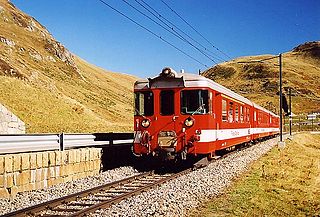
The Furka Oberalp Railway is a narrow gauge mountain railway in Switzerland with a gauge of 1,000 mm. It runs in the Graubünden, Uri and Canton of Valais. Since January 1, 2003, it is part of the Matterhorn Gotthard Bahn when it merged with the BVZ Zermatt-Bahn.

The Eurotunnel Class 9 or Class 9000 are six-axle high-power Bo′Bo′Bo′ single-ended electric locomotives built by the Euroshuttle Locomotive Consortium (ESCL) of Brush Traction and ABB. The class was designed for and is used exclusively to haul the LeShuttle road vehicle services through the Channel Tunnel.
Sea Containers was a Bermudan registered company which operated two primary business areas: transport and container leasing.

Variable gauge systems allow railway vehicles to travel between two railways with different track gauges. Vehicles are equipped with variable gauge axles (VGA). The gauge is altered by driving the train through a gauge changer installed at the break of gauge which moves the wheels to the gauge desired.
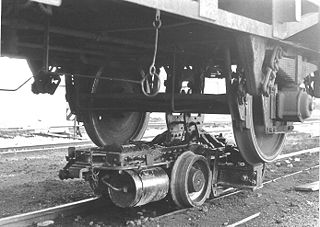
Rollbocks, sometimes called transporter trailers, are narrow gauge railway trucks or bogies that allow a standard gauge wagon to 'piggyback' on a narrow-gauge line. The Vevey system enables a coupled train of standard gauge wagons to be automatically loaded or rolled onto Rollbocks, so that the train can then continue through a change of gauge.
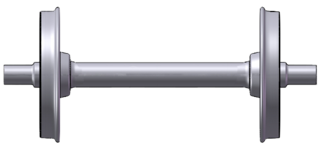
A wheelset is a pair of railroad vehicle wheels mounted rigidly on an axle allowing both wheels to rotate together. Wheelsets are often mounted in a bogie – a pivoted frame assembly holding at least two wheelsets – at each end of the vehicle. Most modern freight cars and passenger cars have bogies each with two wheelsets, but three wheelsets are used in bogies of freight cars that carry heavy loads, and three-wheelset bogies are under some passenger cars. Four-wheeled goods wagons that were once near-universal in Europe and Great Britain and their colonies have only two wheelsets; in recent decades such vehicles have become less common as trainloads have become heavier.

An open wagon forms a large group of railway goods wagons designed primarily for the transportation of bulk goods that are not moisture-retentive and can usually be tipped, dumped or shovelled. The International Union of Railways (UIC) distinguishes between ordinary wagons and special wagons (F/6). Open wagons often form a significant part of a railway company's goods wagon fleet; for example, forming just under 40% of the Deutsche Bahn's total goods wagon stock in Germany.

The GE Transportation C44aci is a model of Australian heavy duty diesel electric locomotive designed by UGL Rail and built at the Broadmeadow factory. It is operated by a number of rail freight operators. The design is based on the National Rail NR class but with some modifications and upgraded features.

Flat wagons, as classified by the International Union of Railways (UIC), are railway goods wagons that have a flat, usually full-length, deck and little or no superstructure. By contrast, open wagons have high side and end walls and covered goods wagons have a fixed roof and sides. Flat wagons are often designed for the transportation of goods that are not weather-sensitive. Some flat wagons are able to be covered completely by tarpaulins or hoods and are therefore suitable for the transport of weather-sensitive goods. Unlike a "goods wagon with opening roof", the loading area of a flat is entirely open and accessible once the cover is removed.
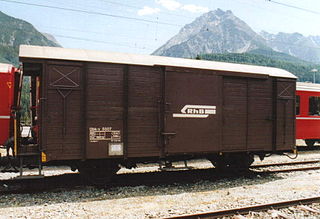
A covered goods wagon or covered goods van is a railway goods wagon which is designed for the transportation of moisture-susceptible goods and therefore fully enclosed by sides and a fixed roof. They are often referred to simply as covered wagons, and this is the term used by the International Union of Railways (UIC). Since the introduction of the international classification for goods wagons by the UIC in the 1960s a distinction has been drawn between ordinary and special covered wagons. Other types of wagon, such as refrigerated vans and goods wagons with opening roofs, are closely related to covered wagons from a design point of view. Similar freight cars in North America are called boxcars.
The International Union of Railways groups all special classes of railway goods wagon into Class U in its goods wagon classification system.

The South African Railways Class 91-000 of 1973 was a narrow-gauge diesel–electric locomotive.

Tiphook PLC was a United Kingdom headquartered transport services company that was registered on both the London and New York stock markets. It was once a constituent of the FTSE 100 Index and became the world's second largest marine container leasing business in the 1990s.
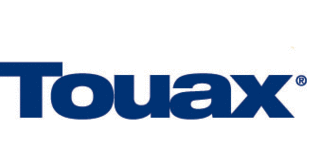
Touax is a French operational leasing company. Its four businesses are river barges, modular buildings, freight railcars, and shipping containers.

Under the British and Imperial classification scheme of locomotive axle arrangements 1Co+Co1 is a classification code for a locomotive wheel arrangement of two eight-wheeled bogies with an articulated inter-bogie connection, each with three axles powered by a separate traction motor per axle and with the fourth non-powered axle in an integral leading pony truck to reduce the axle load. The similar 1Co-Co1 classification is in the same axle configuration, but without the inter-bogie connection.

A pocket wagon is a freight wagon that has been specially designed for the transport of truck semi-trailers. This wagon belongs to the group of flat wagons in special design with bogies and is used in combined transport (CT). The name of these freight wagons comes from the fact that between the narrow longitudinal girders on the outside and also lengthways between the bogies, the so-called pockets are located, in which the wheels of the semi-trailers are particularly low. For flexible use in CT, pocket wagons have hinged latches with ISO spigots on the solebar, so that containers and swap bodies up to 45 ft can be accommodated. As a flat wagon, it bears the UIC generic letter S and, since it is intended for the transport of road vehicles on one level, the code letter d. Since it is also possible to transport containers in a pocket wagon, it bears the UIC generic mark Sdgs. In this context, the code letter g stands for "containers up to 60 feet" and the lower case s for the permitted speed of up to 100 km/h (62 mph). The wagons have a yellow triangle with a black P on the long side. The first pocket wagons were built in Germany as early as 1972 and further developed according to requirements.

The kangourou wagon is a type of rail wagon designed for the transport of semi-trailers. It has a drawbridge forming a pocket in the low position allowing the carrier train of the semi-trailer to be placed and thus to respect the height of the loading gauge.
References
- ↑ Jason T Hesse (1 May 2009), "GE Capital's metamorphosis", www.vrl-financial-news.com, Financial News Publishing Ltd.[ permanent dead link ]
- ↑ Jack W. Plunkett (2007), Plunkett's Transportation, Supply Chain and Logistics Industry Almanac 2007, Plunkett Research, Ltd., GE Equipment Services, ISBN 9781593920852
- ↑ Touax acquires 2 000 GE wagons Railway Gazette International 22 December 2015
- ↑ "GE Capital Services Enters European Rail Market With Acquisition of Cargowaggon", www.thefreelibrary.com, GE Capital Services, 29 August 1997, archived from the original on 31 January 2016, retrieved 11 January 2012
- ↑ "Business Day - Company Briefs", New York Times , 2 May 1998
- ↑ "GE Capital Railcar expands in Europe", Railway Age , 199 (6): 18, June 1998, archived from the original on 31 January 2016
- ↑ General Electric takes over Tiphook Rail The Railway Magazine issue 1167 July 1998 page 67
- ↑ "GE Rail Services (United Kingdom), Manufacturers and services - Rolling stock leasing companies", www.janes.com, Janes Information Services , retrieved 10 January 2012
- ↑ Mike Smith (2003), Liveries on Private Owner Rolling Stock, archived from the original on 14 November 2010, retrieved 9 May 2010
- ↑ "British Rail wagon photographs by Paul Bartlett German Cargowaggon - Eva Bogie flat". 21 October 2004. Archived from the original on 26 June 2010. Retrieved 9 May 2010.
